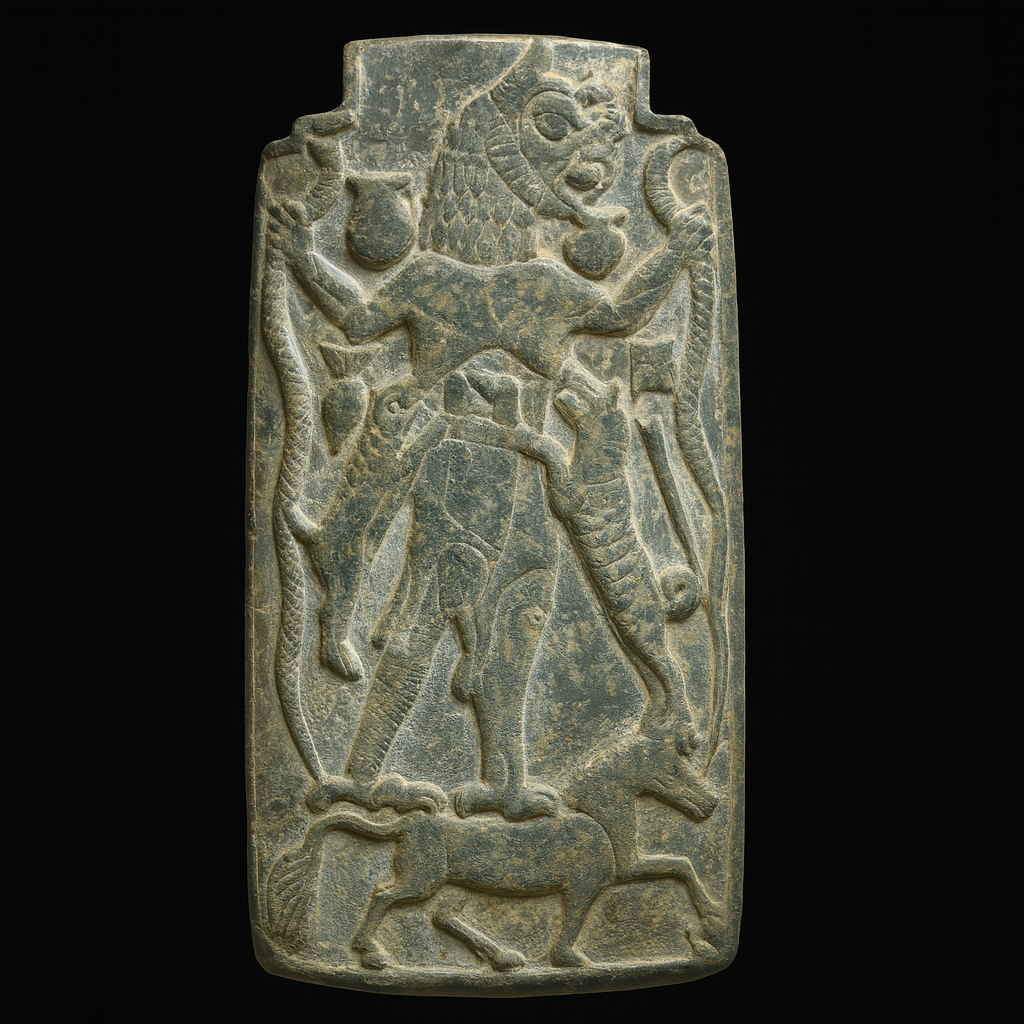Lamashtu

Lamashtu is one of the most terrifying and deeply feared figures in Mesopotamian mythology. Her story may begin in ancient Sumer and Babylon, but the dread she evokes seems to transcend time. To some, she is just a relic of old myths—a savage goddess blamed for infant death and disease. But to others, especially those exploring the deeper patterns behind spiritual deception and interdimensional contact, Lamashtu represents a more enduring threat.
What makes her uniquely important in understanding the phenomena still unfolding in 2025 is that she may be the first recorded interdimensional being in human history. Her name, rituals, and destructive influence were carved into clay thousands of years ago—long before biblical demonology, alien abduction reports, or theories of multidimensional contact. Lamashtu wasn’t just feared—she was described, resisted, and ritualized. Her story signals one of the earliest moments in written history where humanity acknowledged a non-human intelligence interacting with us. For modern researchers, seekers, and those decoding the nature of the phenomena, Lamashtu isn’t just history—she may be the first recorded clue that something else has always been here, living alongside us, influencing us, and feeding off human fear. Her presence in the oldest written texts suggests that what we now call the phenomena may have been known—by another name—since the very beginning.
The civilizations of Sumer, Babylon, and Assyria formed the cultural foundation of ancient Mesopotamia—located in what is now modern-day Iraq. The Sumerians were among the earliest known urban societies, inventing writing and temple-based religion. The Babylonians expanded upon these traditions, producing vast libraries and legal codes. The Assyrians, known for their military strength and far-reaching empire, preserved and transmitted myths across centuries. All three contributed richly to the myths, fears, and rituals in which Lamashtu appears. Unlike many malevolent entities that were invoked by name or feared in hushed tones, Lamashtu was considered a true demoness of independent will. She wasn’t merely a tool of the gods or a cursed spirit; she acted according to her own malevolent desires. This made her unique among supernatural beings and instilled a kind of dread that echoed through generations of Assyrians, Babylonians, and Sumerians.
She was often blamed for causing miscarriages, infant mortality, and diseases in children. Women who had just given birth were considered particularly vulnerable to her influence. The Mesopotamians believed that Lamashtu prowled the nights, sniffing out her prey. She sought to harm babies and pregnant women not for vengeance or punishment, but for her own perverse satisfaction. This was not justice or divine wrath. It was pure, unprovoked malice.
Lamashtu was considered both a demon and a goddess, bearing the divine determinative in cuneiform texts and said to be the daughter of the sky god Anu. Her elevated status set her apart from lesser spirits, allowing her to act independently of the gods and carry out her own terrifying agenda. She appears prominently in Akkadian, Assyrian, and Babylonian traditions, and her mythological functions made her a powerful symbol of unexplained suffering, especially in matters of birth, disease, and childhood.
Her visual depictions are striking and consistent across artifacts. She is typically shown as a hybrid creature with a lioness’s head, donkey’s teeth and ears, bird’s talons for feet, and a hairy body. She often holds snakes or suckles wild animals such as dogs and pigs. One of the most famous reliefs, currently held in the British Museum, shows Lamashtu standing on a donkey, holding serpents in both hands, with lion paws and a grotesque, grinning face. This iconography, also seen on obsidian amulets, marked her both as a threat and as a focal point in protection rituals.
Her deeds, as described in cuneiform incantations and magical texts, are deeply feared and widely recorded. Lamashtu’s origins are firmly rooted in ancient Mesopotamian religion, and she does not appear in the Bible or in Judeo-Christian scriptures. Her name and deeds are preserved in Sumerian, Akkadian, Assyrian, and Babylonian cuneiform texts, especially in magical and exorcistic incantations like the udug-ḫul series. These texts were inscribed on clay tablets and discovered in archaeological sites such as Nineveh and Ashur, with many now housed in the British Museum. Without these sources—carefully translated by scholars like Dr. Irving Finkel—modern knowledge of Lamashtu’s mythology would be virtually lost. The earliest known references to her date back to approximately 1800 BCE, making her one of the most ancient demonic figures ever recorded. She is described as the bearer of seven names and the leader of seven witches, a motif that reflects her pervasive and multifaceted danger. Her name and image were invoked in both protective and exorcistic spells, many of which were studied in depth by scholars like Dr. Irving Finkel, who translated such rituals from ancient tablets.
In the year 1849, modern awareness of Lamashtu began to emerge through the excavation and translation of ancient Mesopotamian tablets, providing scholars with the first glimpses of her story since antiquity.
In a presentation for the British Museum’s Curator’s Corner series, Dr. Finkel elaborated on Lamashtu’s mythological status and the rituals developed to ward her off. He described her vividly as a lion-headed female, often shown riding a donkey, suckling a dog and a wolf, and holding serpents—an unmistakable figure of terror and chaos. According to poetic texts, she would prowl down ancient streets at night, sniffing around doorways in search of newborns. If she found one, she was believed to sneak inside and devour the child, embodying the primal fear of maternal loss. Dr. Finkel suggested she was the personification of the dangers of childbirth, which in the ancient world was perilous and often fatal.
Dr. Finkel also highlighted the protective role of Pazuzu, Lamashtu’s hideous adversary. Despite his grotesque features, Pazuzu served as a powerful guardian, so loathed by Lamashtu that even glimpsing him through a window would cause her to flee. Finkel speculated that their animosity may have stemmed from a mythic divorce—an imaginative explanation for the legendary hostility between them. He also addressed the modern mischaracterization of Pazuzu in popular culture, particularly in films like “The Exorcist,” where he was falsely portrayed as an evil entity.
To banish Lamashtu, Mesopotamian priests performed exorcisms using specific rituals. Sometimes she would be symbolically sent away in a toy boat filled with feminine items like a hairpin or comb—objects meant to distract her as she floated off down the river, ideally toward the distant land of Elam. This ritual represented both psychological release and spiritual cleansing.
To protect themselves and their children, people turned to rituals, amulets, and incantations. One of the most common protectors was Pazuzu, a terrifying demon of the wind who was nonetheless invoked to fight against Lamashtu. Amulets bearing his image were placed near cradles, and prayers were spoken to keep her away. Her threat was not taken lightly—entire households would participate in protective rites, sometimes burying protective spells beneath doorways to block her entry.
In addition to her fearsome actions, Lamashtu had associations with water, particularly the underworld rivers, and with donkeys, further highlighting her connections to both the earthly and the nether realms. Protective artifacts often depicted her alongside donkeys and dogs, reinforcing her association with both the mundane and the demonic.
Similarly, Lamashtu and King Gilgamesh, while both part of the broader Mesopotamian literary tradition, do not intersect in any surviving texts. Gilgamesh appears in epic poetry written in Akkadian on clay tablets, focused on themes of mortality, friendship, and the divine, while Lamashtu exists primarily in magical and religious incantations. Their roles and stories remain entirely separate. Though often compared in modern occult circles, Lamashtu and Lilith come from entirely different mythological systems. Lamashtu is an ancient Mesopotamian demon-goddess appearing in cuneiform incantation tablets, while Lilith emerged much later in Jewish folklore as a rebellious first wife of Adam. Unlike later figures such as Lilith in Jewish folklore or demons in biblical literature, Lamashtu originates entirely outside of the Judeo-Christian tradition.
For those investigating the deeper layers of the phenomena—especially in relation to interdimensional beings, spiritual deception, or ancient forces that may still influence humanity—Lamashtu stands out. She reflects a persistent archetype: a malevolent, interdimensional intelligence that preys on the weak and subverts the sacred. Her continuity across centuries, the rituals to repel her, and her enduring presence in art and belief systems all suggest that ancient peoples were not simply superstitious—but perhaps responding to something very real.
When it comes to the subject of Iraq, one cannot overlook the influence of key power players like George H. W. Bush, Henry Kissinger, Dick Cheney, and George W. Bush—each for their unique role in shaping global events often connected to deeper layers of secrecy. George H. W. Bush, a former CIA director, laid the groundwork for military presence in Iraq under the guise of stability and oil, but with indications of guarding access to deeper truths. Henry Kissinger’s long-standing influence over Middle Eastern policy included dealings that hint at strategic control over regions tied to ancient power centers. Dick Cheney is associated with longevity, advanced technology, and secrets guarded at the highest levels. George W. Bush, who led the 2003 invasion, discussed UFO secrecy and elite decision-making. The key to all of this, is that old technology is advanced technology.
Iraq, the very cradle of civilization and home to ancient Sumer, Babylon, and Assyria, holds more than archaeological significance. The region’s deep mythological record—including the origins of figures like Lamashtu—suggests it may be ground zero for the earliest contact with non-human intelligences. The intense military and political focus on Iraq in modern times has led some researchers to speculate whether there’s more at stake than oil or borders—perhaps a continued struggle for control over ancient knowledge, gateways, or artifacts tied to ‘the phenomena.’ To decode the modern phenomena, Lamashtu offers a disturbing and essential fragment of the greater mystery—because she may be one of the very first documented cases in human history of contact with an interdimensional intelligence. Her presence in some of the earliest written texts signals a moment when humanity began to realize: we were not alone, and perhaps never had been.



